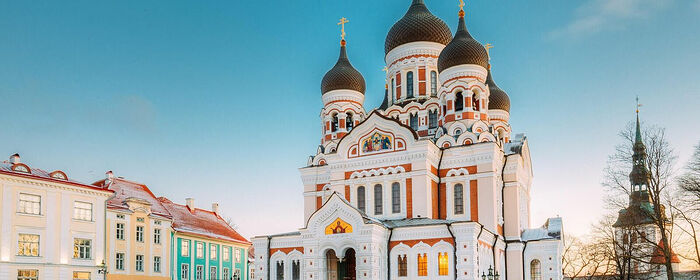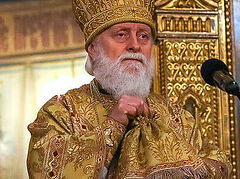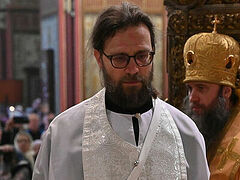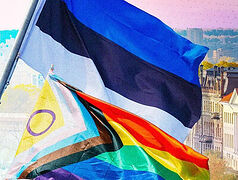Tallinn, April 17, 2024
 St. Alexander Nevsky Cathedral in Tallinn. Photo: i-sng.ru
St. Alexander Nevsky Cathedral in Tallinn. Photo: i-sng.ru
The Estonian Minister of the Interior wants the state to recognize the Moscow Patriarchate as a terrorist organization and therefore ban the Estonian Orthodox Church—an autonomous body within the Patriarchate.
Minister Lauri Läänemets stated on live TV last week that he intends to petition the Riigikogu—Estonian Parliament—to make the relevant decision, reports postimees.ee.
The Estonian Church has responded, and a top Russian Church representative characterized the Minister’s statement as a “witch hunt.”
The Minister’s statement came a week after Ahti Kallikorm, a member of the Isamaa (Fatherland) Party, stated that if the primate of the Estonian Church, His Eminence Metropolitan Evgeny of Tallinn, was deemed a threat to national security and forced to leave the country, then the state should also break its 50-year leases allowing the Church to use 15 church buildings and transfer these properties to Constantinople’s jurisdiction in Estonia.
The Estonian state has been closely monitoring the Estonian Church since the war began in Ukraine, and in October 2022, Met. Evgeny issued a statement, in response to a call from the government, formally distancing himself from Patriarch Kirill’s homily in September of that year in which the Russian primate stated that those who die fulfilling their military duty receive forgiveness of sins for this sacrifice.
Both Estonian politicians now point to the recent statement from the World Russian People’s Council (WRPC), which discusses the war in Ukraine and the concept of the “Russian World” (meaning bearers of Russian culture living both inside Russia and abroad), as their major cause of concern. Minister Läänemets refers to it as a statement “by the Council of the Russian Orthodox Church,” while Kallikorm refers to it as a speech of Patriarch Kirill.
The World Russian People’s Council
According to the WRPC’s charter, its chairman is always the Patriarch of Moscow and All Russia, and it counts a number of hierarchs and other clergy as members. And while the resulting document from the March 27 session was published on the site of the Russian Orthodox Church, the WRPC is a public forum, not an organ of the Russian Church.
Its meetings are traditionally attended by government representatives, leaders of public associations, the highest clergy of Russia’s traditional religions (Orthodoxy, Islam, Judaism, and Buddhism), military leaders, representatives of law enforcement agencies, teachers and students from the country’s largest educational institutions, academics, and cultural figures, delegates from abroad, and numerous youth representatives.
Thus, the WRPC document is neither a statement of a Church Council, nor of the Patriarch personally, but of a public forum that includes top ecclesiastical figures.
The WRPC document
The document resulting from the extraordinary congress is described on patriarchia.ru as “a directive addressed to the legislative and executive authorities of Russia,” summarizing the most significant proposals put forward during the Congress.
Among other topics, the document addresses the war in Ukraine, and the “Russian World.”
War in Ukraine
The document states: “The special military operation is a new stage in the national liberation struggle of the Russian people against the criminal Kiev regime and the collective West behind it, which has been waged in the lands of Southwestern Rus’ since 2014.”
The Russian people are defending their “lives, freedom, statehood, civilizational, religious, national and cultural identity, as well as the right to live on their own land within the borders of a single Russian state,” the document continues.
And according to the Council, the war in Ukraine is, from a spiritual and moral point of view, a “holy war,” with Russia “defending the unified spiritual space of Holy Rus’.”
Russia and its people are therefore “fulfilling the mission of ‘restraining,’” the Council writes, referring to 2 Thess. 2:7 (For the mystery of lawlessness is already at work; only he who now restrains will do so until he is taken out of the way), which is traditionally interpreted as the Roman empire/emperor, which continued with the Orthodox Russian Empire and the tsar.
Russia is “protecting the world from the onslaught of globalism and the victory of the West, which has fallen into Satanism.”
This section of the document concludes:
After its completion, the entire territory of modern Ukraine should enter the zone of exclusive influence of Russia. The possibility of the existence of a Russophobic political regime hostile to Russia and its people in this territory, as well as a political regime controlled from an external center hostile to Russia, should be completely excluded.
The “Russian World”
The document then covers the concept of the “Russian World,” saying “the borders of the Russian world as a spiritual and cultural-civilizational phenomenon” are much broader than those of Russia itself, but includes anyone around the world who values Russian tradition, culture, and sacred objects as “the highest value and meaning of life.”
Further:
The supreme meaning of the existence of Russia and the Russian World created by it—their spiritual mission—is to be a worldwide “restrainer,” protecting the world from evil. The historical mission is to repeatedly bring down attempts to establish universal hegemony in the world—attempts to subjugate humanity to a single evil principle.
The unity, including spiritual, of the Russian people is a key condition for the survival and development of Russia and the Russian World, the document affirms. And the family is the foundation of the Russian World.
Ahti Kallikorm argues that the Estonian Church should be deprived of its churches because, according to him, it has been silent since the WRPC document was published, and “Silence, as you know, is a sign of consent.”
Estonian Orthodox Church’s response
However, several days before the comments from Kallikorm, the chancellery of the Estonian Church had issued a statement clarifying that Met. Evgeny has not participated in the activities of the WRPC for more than six years now.
Further, on April 2, the Holy Synod of the Estonian Orthodox Church issued a statement emphasizing that the WRPC is “a non-governmental association of another state, whose decisions, despite the participation of representatives of the Russian Orthodox Church, are in no way connected with the Estonian Orthodox Church of the Moscow Patriarchate.”
The Synod recalls that according to the tomos it received from Patriarch St. Tikhon in 1920, the Estonian Orthodox Church is independent “in economic, administrative, educational, and social matters concerning the Church.”
Further, the Estonian hierarchs do not recognize the WRPC document “because it does not correspond, in our opinion, to the spirit of the teaching of the Gospel.” They continue:
The idea of the “Russian World” (Russky Mir) has become a substitute for the teaching of the Gospel, and as Christians, we cannot accept it. The Church is called to preach peace and unity in Christ. This is the message we hear in our churches every day. Thanks to this, people of different nationalities, different views and beliefs can participate in the service and find spiritual support and comfort.
The Estonian Church issued another statement a week later, entitled, “The Position of the EOC-MP in the Crisis Situation Between the Church and State,” emphasizing that the parishioners of the Estonian Church, coming from various countries and backgrounds, are all residents of Estonia who are constitutionally guaranteed “freedom of religion, conscience, and thought.”
And though historically and canonically connected to the Moscow Patriarchate, the Estonian Church “cannot and does not bear responsibility for the words of the Patriarch…
“Patriarchs change, but the canonical ties remain. People in the Church can make mistakes. But it’s not possible to change your Church affiliation with every human mistake.”
And concerning calls to separate from the Moscow Patriarchate, the Estonian Church responds that as an autonomous Church, it does not have the authority to change its status (according to the statutes of the Moscow Patriarchate, only a Local Council, involving all hierarchs, as well as clerical, monastic, and lay representatives, can change the status of a Church within the Patriarchate).
Further, “the ROC hasn’t accepted anything at the Church level that would force us to sever our canonical connection with it… the WRPC is not a Church structure, and moreover, the document adopted there cannot serve as a basis for severing any Church ties.”
Praying for the Patriarch means entreating God to enlighten him to act in accordance with truth, the EOC statement reads. “Prayer is not understood as an endorsement of a person’s actions.”
Regarding calls to merge with Constantinople’s jurisdiction in Estonia, the Church recalls that after Constantinople established a parallel jurisdiction in the early 90s, a compromise was reached for the sake of peace whereby parishes could decide which jurisdiction to adhere to. Thus, forcing parishes to change jurisdiction would represent a violation of their right to freedom of religion, conscience, and beliefs.
And regarding accusations that the Estonian Church creates security threats, the statement emphasizes that although the Church leadership and clergy understand themselves as part of Estonian society and “do not call for any kind of confrontation … We are faced with the exact opposite, primarily through the media, but also when communicating with government officials.”
The statement concludes:
By opposing a particular Church, the state opposes a certain part of its residents and citizens, against their religious freedom. Is inciting hatred against us justified? We do not feel that we have given a reason for this. Isn’t that what increases the security risk?
Response from a top Russian Church representative
A response was also offered by Vladimir Legoida, chairman of the Moscow Patriarchate’s Synodal Department for Relations with Society and the Media, saying the Estonian Interior Minister’s call to label the MP as a terrorist organization “returns the dark days of religious wars, the St. Bartholomew’s Day Massacre, and witch hunts to Estonia.”
“It’s obvious to any sane person that the Moscow Patriarchate is not engaged in terrorist activities … The Estonian Orthodox Church … is certainly a law-abiding organization.”
He concludes:
This statement is simply a theater of the absurd in which Estonian politicians play roles, probably trying to garner sympathy from the owner of this institution. Fighting the Russian Church and Russian culture has become a kind of mental narcotic that they try to feed to the Estonian voter so that he forgets about real problems.
The Church and the faith are called to build bridges between societies and peoples in the most difficult times. And it’s not the fault of Church people that politicians are destroying these bridges.
The WRPC document has also received a negative response from the Department of External Church Relations of the Ukrainian Orthodox Church, His Eminence Metropolitan Innokenty of the Moscow Patriarchate’s Diocese of Vilnius (Lithuania), and the Archdiocesan Council of the Moscow Patriarchate’s Archdiocese of Orthodox Churches of the Russian Tradition in Western Europe.
Follow OrthoChristian on Twitter, Vkontakte, Telegram, WhatsApp, MeWe, and Gab!




